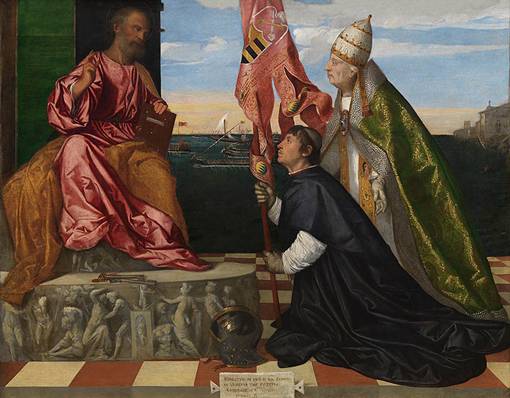5.7: Tiziano, Virgen de la Familia Pesaro
- Page ID
- 103243
La Dra. Beth Harris y el Dr. Steven Zucker proporcionan una descripción, perspectiva histórica y análisis de la Virgen de Tiziano de la Familia Pesaro.
Tiziano, Virgen de la Familia Pesaro, 1519—26, óleo sobre lienzo, 16′ x 9′ (Santa Maria Gloriosa die Frari, Venecia).
Este retablo fue encargado por Jacopo Pesaro para la capilla familiar en la Iglesia de Santa Maria Gloriosa dei Frari en Venecia. El cuadro muestra a la Virgen y el Niño con San Francisco (a la derecha mirando hacia arriba al Niño Cristo), San Antonio (en el extremo derecho), San Pedro (en el centro mirando hacia abajo a Jacopo Pesaro, el donante, en la parte inferior izquierda), un soldado sosteniendo una pancarta (quizás San Miguel) y un turco en turbante. Este sujeto —la virgen y el niño con santos dentro de un espacio unificado— se llama “sacra conversazione”. Esto es diferente de los retablos medievales que mostraban a los santos en paneles separados de la Virgen y el Niño, generalmente en marcos elaboradamente dorados (por ejemplo, esta pintura de Paolo Veneziano). Aquí tienen sentido los santos Francisco y Antonio, ya que Santa Maria dei Gloriosa dei Frari es una Iglesia Franciscana.
Pesaro fue un noble veneciano y comandante de las fuerzas navales del Papa en la exitosa recapturación de la isla de Santa Maura (un territorio veneciano) de los turcos en agosto de 1502.
Una pintura anterior de Tiziano (quizás la primera obra sobreviviente de Tiziano) encargada por Pesaro justo después de la victoria naval, muestra un tema similar. Aquí, Pesaro está siendo presentado a San Pedro por el Papa Alejandro VI (el mismo papa cuya insignia aparece en la Virgen de la Familia Pesaro.

Colaboradores
- La Virgen de Tiziano de la Familia Pesaro. Autor: Dra. Beth Harris y Dr. Steven Zucker. Proporcionado por: Khan Academy. Ubicado en: https://web.archive.org/web/20140215031434/http://smarthistory.khanacademy.org/titian-madonna-of-the-pesaro-family.html. Licencia: CC BY-NC-SA: Atribución-NoComercial-CompartirIgual


